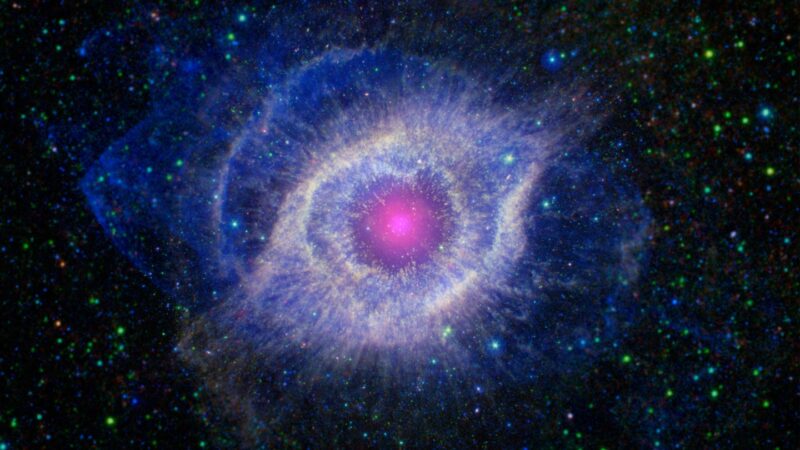A never-ending, X-ray explosion coming from a dead star has posed a mystery — until now. This steady radiation appears to come from scorching-hot wreckage left behind by the annihilation of a giant planet.
The discovery stems from four decades of X-ray observations of the Helix Nebula. It lies some 650 light-years from Earth. The stream of X-rays has remained constant for at least 20 years. Now, scientists suggest a convincing explanation for why. The ruins of a Jupiter-sized world are streaming toward the nebula’s white dwarf, the remains of a dying star. The collision makes the frazzled star glow in X-rays.
Researchers shared their findings in the January Monthly Notices of the Royal Astronomical Society.
“We don’t know very much about how planetary systems behave after their star transitions from a red giant to a super long-lived white dwarf,” says Paul Byrne. He’s a planetary scientist who did not take part in the research. He works at Washington University in St. Louis, Mo. The new work offers “a potential glimpse of the far, far-off future of the solar system,” he says.
The Helix mystery
The Helix Nebula is like a colorful explosion frozen in time. Its halo of gas was cast off by a star that was losing its nuclear fuel. At its center lies a white dwarf — the leftover heart of that once-mighty star.
The white dwarf is not quiet, either. It appears to be “screaming” in X-rays. This emission was picked up by two space-based observatories. NASA’s Einstein Observatory spotted it in the early 1980s. Then in the 1990s, the internationally operated ROSAT saw it.
“It is very unusual to find single white dwarfs with an X-ray emission,” says Sandino Estrada-Dorado. He’s an astrophysicist at the National Autonomous University of Mexico in Mexico City.
To try and crack the case, Estrada-Dorado and his team studied more recent observations of the nebula. Some were taken by NASA’s Chandra X-Ray Observatory in 1999. Others came from the European Space Agency’s XMM-Newton mission in 2002.
X-ray marks the fuel source
The team found that the X-ray emissions aren’t a fluke but rather a constant. To burst so brilliantly for so long requires a hefty fuel source. One possibility is that matter from a big, blasted planet has been raining down onto the white dwarf. This debris is heated so fiercely that it shines brightly in X-rays.
Calculations show the X-ray emissions are very intense. That means a Jupiter-sized world is the most likely culprit.
Long ago, such a planet might have drifted too close to the white dwarf. The flyby would have shredded the planet. The disk of debris left behind could then power the X-ray blaze.
X-rays could offer researchers a new way to explore the final chapters of planets. It could even help scientists study the core of those destroyed worlds.
“We have precious little data about the deep interiors of giant planets,” Byrne says. It’s possible that through observations here and from other white dwarfs “we can better distinguish the signals of the star from the infalling planet,” he says. “Then we might be able to tease out information about the planet’s composition, too.”

















